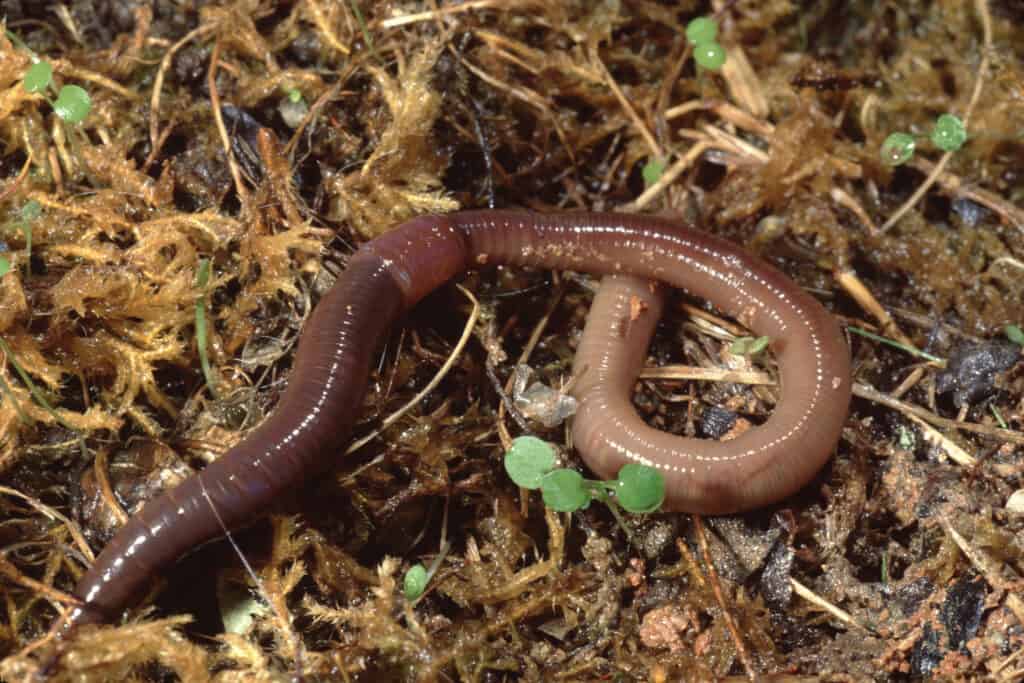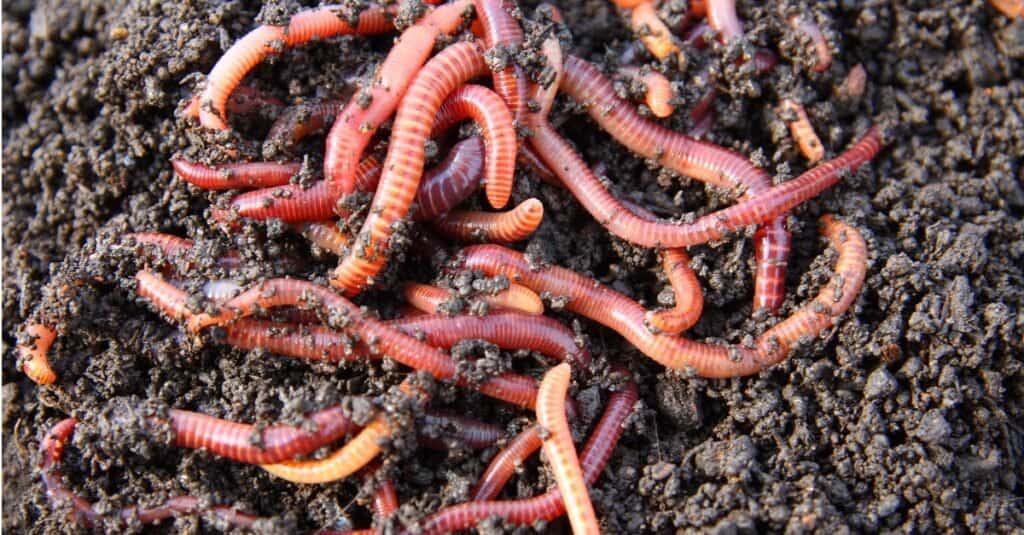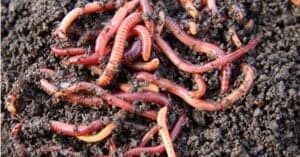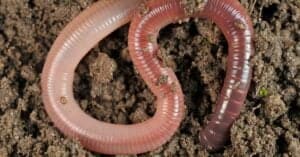Ever examined a nightcrawler up close? If so, you probably wondered what this thing eats. Let’s explore the diet of nightcrawlers and other interesting facts about this specie.
We’re going to explore what Lumbricus Terrestris, also called a nightcrawler or dew worm, consumes. This creature is a large earthworm measuring 4 and 8 inches long with a pink to red-brown coloration believed to have originated in Europe. The worm has since spread to North America, where it is popularly used as bait for fishing. Let’s get to the bottom of their preferred foods without further ado!
What Foods Do Nightcrawlers Consume?

The
Earthworm
Nightcrawler (Lumbricus Terrestris).
©Liz Weber/Shutterstock.com
Nightcrawlers eat plants, dead insects, feces, and microorganisms in the soil. Often, the worms will eat the decaying matter along with bits of soil.
Nightcrawlers are detritivores, meaning they mostly eat decomposing plant matter, feces, and animal parts. These earthworms are essential in contributing to the breakdown of plants and animals and the remineralization of the soil.
Nightcrawlers are one of many species of detritivores. They are similar to others in that they live in woodlands where their preferred plant matter is abundant. They specifically focus on consuming foods residing at the topmost soil layers, also called the A-horizon or topsoil.
A Complete List of What Nightcrawlers Eats
Nightcrawlers have preferences in the types of food they eat. They demonstrate a preference for detritus which has high levels of nitrogen and calcium.
With that in mind, here is a more specific, complete list of foods that nightcrawlers prefer to eat, including:
- Aspen leaves
- Ash leaves
- Maple leaves
- Basswood leaves
- Sugar maple leaves
- Fungi
- Decomposing fruit
- Nematodes
- Roots
- Decomposing insects like snails and other
- Decomposing animals
- Bacteria
- Grass clippings
- Protozoa
Nightcrawlers that are raised by farmers for use in fishing or gardening are typically fed additional foods, including:
- Chicken mash
- Pig mash
- Cereal
- Bread
- Lard
- Cornmeal
- Shortening
- Various decomposing bits of fruit and vegetables
As you can see, nightcrawlers consume a wide variety of meals. Keep in mind that nightcrawlers don’t start eating a recently deceased animal. They’ll need the decaying process to begin before participating in the cycle.
Still, these earthworms will eat many different decaying items in the uppermost levels of soil.
How Do Nightcrawlers Find Food?

The vast diet of earthworms allows them to break down plant matter and bacteria.
©iStock.com/Mik122
Nightcrawlers are like other earthworms who burrow to find their food, sometimes chasing the chemical trail left by decomposing materials. While they lack a sense of smell, they have a sense of touch.
They burrow into the soil and eat decaying matter they find on the way. Sometimes, they will follow other worms that have gone into an area to finish off the remains.
Nightcrawlers living in an area plentiful with decaying leaves and plant matter can even pull bits of the food into their burrows with their mouths to consume it later. They will leave if they cannot find food in their immediate area. However, eating is less of a priority compared to staying moist, which allows them to breathe.
How Do Nightcrawlers Consume Food?
Nightcrawlers eat food by drawing organic matter and soil into their mouths and passing it through their digestive system. These earthworms have surprisingly powerful mouths that they can use to move debris and inedible matter to get to more edible bits of food.
Once the earthworm has consumed food, it passes through its digestive system. The earthworm’s feces are called castings, rich in nitrogen, potassium, phosphorus, and other nutrients. Like other detritivores, nightcrawlers play an essential role in continuing the nutrient cycles of areas in which they live.
Humans sometimes harvest these castings and add them to gardens to revitalize specific soil areas without resorting to synthetic fertilizers.
Are Nightcrawlers Dangerous to Humans?
Nightcrawlers are not dangerous to humans in the same way that a bear is dangerous to a human. They can’t cause any direct harm to human beings. However, Lumbricus terrestris and other members of their suborder are invasive species in North America. As a result, they are having a noticeable impact in areas where they congregate in high numbers.
These earthworms interrupt the typical nutrient cycle in many of the woodlands in which they live. This is significant because the temperate forests of North America have plant life that relies on the presence of layers of decaying plants on the ground to thrive. The nightcrawlers are breaking down the organic matter, so the new plants have fewer nutrients in the soil to help them grow.
The problem of invasive earthworms in North America is more complex than this, but it’s enough to know that their presence negatively impacts nutrient cycles, soil profiles, and the growth of many trees and plants.
What Do Nightcrawlers Eat in Winter?
Nightcrawlers typically don’t eat much in the winter unless warm weather prompts them to return to the surface and feed. These earthworms use a sort of hibernation to survive the winter.
They will burrow down upwards of six feet into the soil, below the frost line, and stay there to avoid the harsh winter conditions. The worms will curl up, coat themselves in an insulating slime, and wait for the warm spring rains to wash into the soil.
Nightcrawlers are essential creatures that play an important role in breaking down decaying organic matter. They are also an invasive species in parts of North America despite being a popular choice of bait for fishing as well as a welcome sight in many home gardens.
While it may be hard to conceptualize how these creatures eat, their eating methods are quite common in the world of small invertebrates.
Bonus: Which Fish Can Be Caught Using Nightcrawlers for Bait?

Crappie are one of many types of fish that will take a hook baited with a nightcrawler.
©Steve Oehlenschlager/Shutterstock.com
Nightcrawlers and other worms are popular bait among anglers for one simple reason: almost every species of fish will eat them. A big, juicy, wriggling, nightcrawler is just too sweet for a fish to pass up! Even fish that have been caught many times will still take a chance on a dangling worm – the temptation is too great! Fish caught on nightcrawlers include:
- Bluegill
- Perch
- Crappie
- Rock Bass
- Bullhead
- Catfish
- Bowfin
- Smallmouth Bass
- Largemouth Bass
- Northern Pike
- Trout
According to seasoned fishermen, the only problem with using nightcrawlers is that smaller fish will take the bait before the big ones get the chance. If you are looking to catch a mess of panfish to fry – this is no problem. If you are after a trophy catch or trying to catch a lot of bass – artificial lures may be best because they weed out the smaller fish. On the other hand – big, fat nightcrawlers will attract big bass. Maybe swapping live and artificial bait will yield the best result!
The photo featured at the top of this post is © Liz Weber/Shutterstock.com
Sources
- Science Direct, Available here: https://www.sciencedirect.com/science/article/abs/pii/S0016706119312005
- Science Direct, Available here: https://www.sciencedirect.com/science/article/pii/S0929139317303864
- University of Minnesota Extension, Available here: https://extension.umn.edu/yard-and-garden-insects/nightcrawlers
Thank you for reading! Have some feedback for us? Contact the AZ Animals editorial team.






